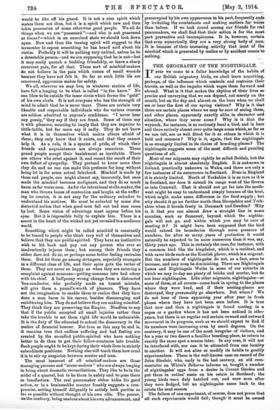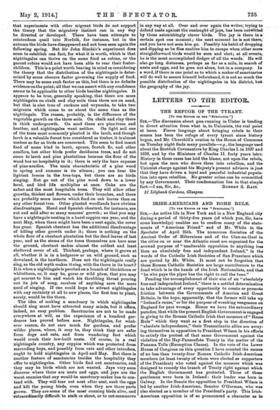THE GEOGRAPHY OF THE NIGHTINGALE.
IF ever we come to a fuller knowledge of the habits of our British migratory birds, we shall learn something, perhaps, of the influence which controls and restrains their travels, as well as the impulse which urges them forward and abroad. What is it that makes the rhythm of their lives so precise and unvarying that we can depend, not merely on the month, but on the day and almost on the hour when we shall see or hear the first of our spring visitors? Why is it that there are certain places where we may be sure of seeing them, and other places, apparently exactly alike in character and situation, where they never come P Why is it that the wryneck, for instance, is so curiously local a bird, and is here and there entirely absent over quite large areas which, so far as we can tell, are as well fitted for it as others in which it is bold and common ? Why is it, again, that the nightingale is so strangely limited in its choice of breeding-places P The nightingale suggests some of the most difficult and puzzling
questions of all ,
Most of our migrants may rightly be called British, but the nightingale is almost absolutely English. It is unknown in Ireland, practically unknown in Wales, and there are only a few instances of its occurrence in Scotland. Even in England it is strictly limited. North of Yorkshire it is as rare as it is in Scotland, nor does it extend its range west of the Severn or into Cornwall. . That it should not go far into the south- west might be easy to understand simply because of the heat, which might make some difference in the food supply ; but why should it go no further north than Shropshire and York- shire when it breeds freely in Denmark and Sweden P Why is it that you can almost draw a straight line in some counties, such as Somerset, beyond which the nightin- gale will not go, and within which you may be sure of meeting it ? It might have been supposed that the bird would extend its boundaries through mere pressure of numbers, for after so many years of protection it would naturally be expected to be more numerous than it was, say, thirty years ago. This is certainly the case, for instance, with a common bird like the kingfisher, which is a resident, and with rarer birds such as the Kentish plover, which is a migrant. But the numbers of nightingales do not, as a fact, seem to increase, and may even be diminishing. There are Nightingale Lanes and Nightingale Walks in some of our suburbs in which we may to-day see plenty of bricks and mortar, but do not hear nightingales. Like other migrants, nightingales—or some of them, at all events—come back in spring to the places where they were bred, and if their nesting-places are destroyed, they presumably go elsewhere. But where ? We do not hear of them appearing year after year in fresh phloem where they have not been seen before. It is true that now and then a nightingale is found nesting in a copse or a garden where it has not been noticed in other years, but there is no regular and certain onward and outward movement in its progress, such as we should expect to find if its numbers were increasing even by small degrees. On the contrary, it may be one of the most irregular of visitors, and for a year or two desert a familiar breeding-place, to return to exactly the same spot a season later. In any case, it will not be interfered with, nor can it be attracted from one locality to another. It will not alter or modify its habits to gratify experimenters. There is the well-known ease on record of Sir John Sinclair, who, early in the last century, an old com- mentator on White's Belborne informs us, bought a number of nightingales eggs from a dealer in Covent Garden and put them in robins' nests on his estate in Scotland; the young birds were duly hatched out, and were seen after they were fledged, but no nightingales came back to the estate the next season.
The failure of one experiment, of course, does not prove that
all such experiments would ; though it must be owned
that experiments with other migrant birds do not support the theory that the migratory instinct can in any way be diverted or developed. There have been attempts to reintroduce quail into Norfolk, for instance, but in the autumn the birds have disappeared and not been seen again the following spring. But Sir John Sinclair's experiment does seem to establish one fact, for what it is worth, which is that nightingales can thrive on the same food as robins, or the parent robins would not have been able to rear their foster- children. This is a point worth bearing in mind in considering the theory that the distribution of the nightingale is deter- mined by some obscure factor governing the supply of food. There may be some such factor as this, but there is no definite evidence on the point; all that we can assert with any confidence seems to be applicable to other birds besides nightingales. It appears to be true, generally speaking, that there are more nightingales on chalk and clay soils than there are on sand, but that is also true of cuckoos and wrynecks, to take two migrants which come to us about the same time as the nightingale. The reason, probably, is the difference of the vegetable growth on the three soils. On chalk and clay there is thick undergrowth. On sand there are pine-trees and heather, and nightingales want neither. On light soil one of the trees most commonly planted is the larch, and though larch is a valuable forest tree considered as timber, it is almost useless so far as birds are concerned. Tits seem to find insect food of some kind in larch, spruce, Scotch fir, and other conifers, but other birds prefer deciduous trees, and do not come to larch and pine plantations because the floor of the wood has no hospitality in it ; there is only the bare expanse of pine-needles. The main characteristic of a pine wood in spring and summer is its silence ; you can hear the lightest breeze in the tree-tops, but there are no birds singing. But go out of the pine wood down to a lower level, and bird life multiplies at once. Oaks are the safest and the most hospitable trees. They will allow other growths, thicket and flowers, under their branches, and there are probably more insects which feed on oak leaves than on any other forest tree. Other planted woodlands have obvious disadvantages. Hazel and Spanish chestnut, for instance, are cut and sold after so many seasons' growth ; so that you may have a nightingale nesting in a hazel coppice one year, and the next May, when there might have been a nest again, the cover has gone. Spanish chestnut has the additional disadvantage of killing other growth under it; there is nothing on the whole floor of a chestnut plantation but the dead leaves of last year, and as the stems of the trees themselves are bare near the ground, chestnut makes almost the coldest and least sheltered cover of all_ Thickest, perhaps, where it grows at all, whether it is in a hedgerow or on wild ground, such as downland, is the hawthorn. Does not the nightingale really sing, as the old myth makes it sing, with the thorn in its heart ? It is when a nightingale is perched on a branch of blackthorn or whitethorn, or, it may be, gorse or wild plum, that you may get nearest to him and watch his throbbing throat pouring out its jets of song, careless of anything save the mere need of singing. If one could hope to attract nightingales with any certainty at all to new places, the first tree to plant, surely, would be the thorn.
The idea of making a sanctuary in which nightingales should sing mast have attracted many minds, but it offers, indeed, no easy problem. Sanctuaries are not to be made everywhere at will, as the experience of a hundred gar- deners has proved before now. Nightingales, for what- ever reason, do not care much for gardens, and prefer wilder places, where, it may be, they think they are safer from dogs and cats, and from wandering feet which would crush their low-built nests. Of course, in a real nightingale country, any coppice which was protected from marauding boys, and possibly from cats and other intruders, ought to hold nightingales in April and May. But there is another feature of sanctuaries besides the hospitality they offer to nightingales. Other birds find out sanctuaries, and they may be birds which are not wanted. Jays very soon discover where there are nests and eggs, and jays are the worst enemies that any would-be sanctuary-maker has to con- tend with. They will tear out nest after nest, suck the eggs and kill the young birds, even when they are three parts grown. They are some of the most cunning birds alive, and 'extraordinarily difficult to stalk or shoot, or to out-manteuvre in any way at all. Over and over again the writer, trying to defend nests againit the onslaught Ofsjays, has been "outwitted by these astonishingly clever birds. The jay is there in a' certain spot one moment ; the next moment he is not there, and you have not seen him go. Possibly his habit of dropping and dipping as he flies enables him to escape when other more straightforward birds would be seen and shot; at all events, he is the most accomplished dodger of all the woods: He will also go long distances, perhaps as far as a mile, in search of nests and eggs, and he goes not alone, but in a company. In a word, if there is one point as to which a maker of sanctuaries will do well to assure himself beforehand, it is not so much the possible distribution of the nightingales in his district, but the geography of the jay.















































 Previous page
Previous page